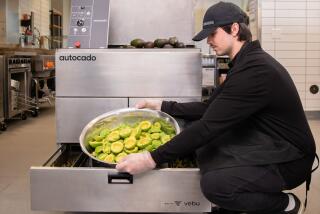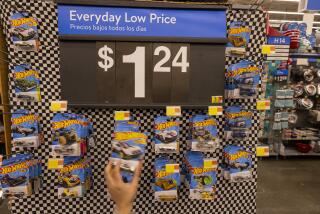Industry Teaching the Old Vending Machine New Tricks
- Share via
NEW ORLEANS — No cash? Swipe your credit or ATM card and get a soda. Enjoy refreshing Internet headlines, no extra charge.
Or bypass that candy bar or bag of chips and get some real nutrition--a steaming plate of pasta, with a choice of sauces.
It’s a New! Improved! world in the vending business, as displayed at this month’s National Automatic Merchandising Assn. convention. With $36 billion a year dropping into vending machines, new hardware attracted plenty of attention.
The Internet-equipped machines offer a headline and photo each for news, sports and weather, along with a local weather report and interactive ads. A touch turns the display screen into a keypad where one can enter an e-mail address to get a coupon from the advertiser.
The machines are being tested in Denver and Jacksonville, Fla.
“We’re seeing a 20% increase in sales volume simply due to the convenience of using credit cards,” said Stephen Herbert, president of USA Technologies, the Wayne, Pa., company that developed the Internet/swipe-card connection.
And since the machine is connected to the Web, the owner can use the same online connection for sales and refill information.
Other technologies are being applied to the challenge of keeping the machines filled.
Just about every machine made for the last two years or so is set up for DEX, the vending industry’s digital exchange standard for transmitting inventory data. Warehouse crews can use the information to load trucks with the right product mix to refill each machine on a particular driver’s route.
Not having to overstock their trucks or to open machines just to see what’s needed saves a great deal of time, said Philip Murphy, sales vice president at Holland, Mich.-based Rutherford Associates, which makes software to make sense of all the numbers.
“We find they’re saving two, 2 1/2 hours per route. Now they have a huge amount of time to do more stops,” which means more money for both driver and employer, he said.
Other new machines aim to broaden the range of offerings.
Paul Cerullo, head of Aramark’s business services office in Windsor Locks, Conn., scoped out one built to cook and serve pasta.
Atop the machine stood a clear plastic caddy loaded with a dozen servings of uncooked angel-hair pasta. A push of a button dropped the pasta into a pot filled with water heated to 270 degrees Fahrenheit.
After two minutes of cooking and a pass through the draining chamber, the angel hair dropped onto a plate. The machine also held two sauces, kept heated to 150 degrees to stave off bacteria.
After a bite, Cerullo offered a product review.
“What this tells me is that whoever makes the sauce makes a good sauce,” he said. “The pasta is more than a little al dente.”
That is adjustable, said Steve Young, president of Global Equipment Services of St. Louis, which makes the machine.
Cerullo returned later with another Aramark executive, who signed for a trial run in the Rochester, N.Y., area, Young said.
Engineers are also working on a common problem: delivering bottled diet soda so it doesn’t froth at the neck. Coca-Cola and Maytag Commercial Solutions-Dixie Narco demonstrated a machine that sends a conveyor belt up to catch the bottle or can, then lower it and carry it across to the vending slot.
Regular Cokes from the machine had just a bit of fizz on top, but the diet version still bubbled over. For some reason, Diet Coke is harder to keep quiescent, acknowledged Rick Tarleton, Maytag’s regional sales manager, based in Williston, S.C..
Still, he said, they’re nowhere near as explosive as those dropped in standard machines.
A hundred feet or so away, Bill Wassink and Bill Berton of Loose Ends Vending Inc. of Batavia, N.Y., were looking at another glass-fronted machine. This one sent a little padded cage up to collect each bottle and carry it to the vending slot.
Dave Dunnigan of Automatic Products International of St. Paul, Minn., said his soft-delivery machine is still not ready for test-marketing.
Wassink said too-fizzy soda is the top complaint he gets from vending-machine users.
“When people are at home, they can crack the top and wait for the fizz to go down,” he said. “But it’s like they lose their brains when they buy from a machine. They open it all at once, and get sprayed, and get upset.”
National Automatic Merchandising Assn. can be reached on the internet at https://www.vending.org.
More to Read
Inside the business of entertainment
The Wide Shot brings you news, analysis and insights on everything from streaming wars to production — and what it all means for the future.
You may occasionally receive promotional content from the Los Angeles Times.










